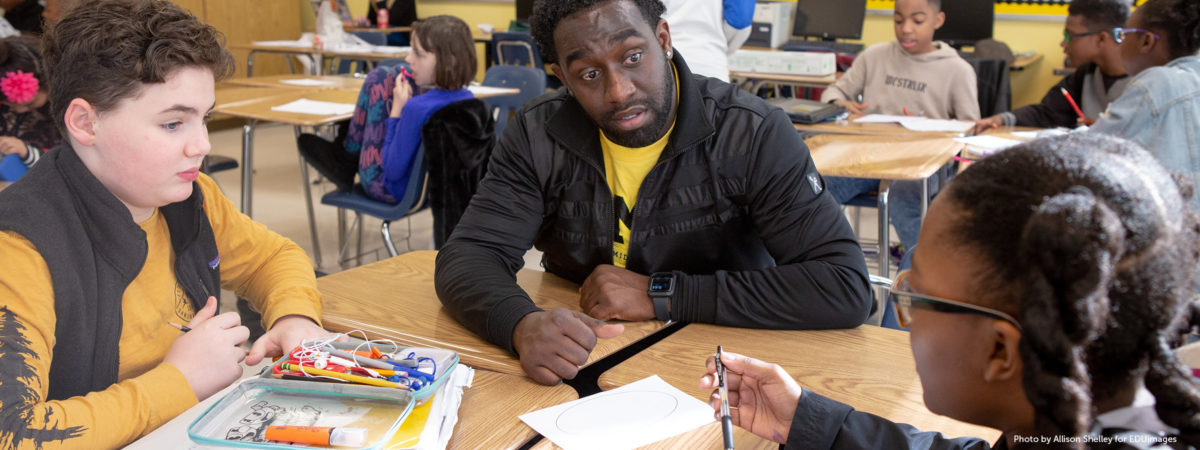
February 7, 2022 | By Maima Chea Simmons
“The educators who had the greatest impact on me as a youth recognized my personhood by actively developing a relationship with me, challenged their explicit and implicit biases in visible ways, and valued multiple perspectives within their classroom.” – Maima Chea Simmons, Black Girls’ Literacies
Culturally responsive education is not a one-size-fits-all approach. It requires educators to learn deeply about the intersectional identities of their students to move beyond simplified or tokenized acts of diversity and inclusion. In my experience as a teacher, instructional coach, district leader, and education researcher, it has been critical to foster spaces where adults can first reflect on their own identities, biases, and lived experiences. Developing their own cultural awareness, discussing race, and selecting culturally responsive texts are three strategies, supported by research, that help educators to sustain inclusive learning environments.
When educators understand more about their implicit and explicit biases, it helps us to identify and address how these biases impact practice. Copur-Gencturk and colleagues (2019) explored the impact of teachers’ biases on their perceptions of students’ math abilities. Their study found that while the teachers exhibited minimal bias when assessing the accuracy of mathematical solutions, they significantly underestimated certain students’ mathematical ability, with the largest bias against Black and Hispanic girls. These results were consistent across teachers of different racial groups. These findings are important to consider because teachers’ implicit perceptions of students’ academic abilities can impact students’ perceptions of themselves and contribute to negative self-fulfilling prophecies.
There are resources for educators that may help alleviate some of these negative effects. For example, Williams and colleagues (2020) developed the Aftermath framework focused on how teachers can highlight and understand Black students’ agency and cultural capital while attending to the pervasively damaging frames of racial biases (such as stereotypes, blame, deficit perspective, and Eurocentric education) perpetuated in educational spaces. The Guide for Culturally Responsive Practice, developed by the Learner Variability Project, is another tool that can help educators reflect on their lived experiences so that they can engage in productive conversations with their students, colleagues, and communities.
Curricular decisions affect the lived experiences of students daily. In some contexts, teachers make curricular decisions. In other contexts, school and/or district leaders make curricular decisions. No matter the decision-maker, curriculum is a powerful lever that can cultivate identity, criticality, intellect, skills, and joy within students (Muhammad, 2020). Research shows that classroom libraries in the United States vary greatly and lack criticality and representation of culturally and historically marginalized identities (Crisp et al., 2016; Harmon et al., 2019; Kleekamp & Zapata, 2018). As a district leader conducting a curriculum adoption, it was crucial for me to consider how we could use the curriculum to center student identity, build upon their funds of knowledge, and promote critical literacy.
Selecting culturally responsive texts and incorporating students’ cultural practices in literacy and math instruction can support an inclusive learning environment. The Culturally and Historically Responsive Literacy Framework, developed by Dr. Gholdy Muhammad, is an equity model that can support the development and evaluation of an anti-racist curriculum that celebrates the identities, histories, and accomplishments of culturally and historically marginalized people. The Culturally Responsive Curriculum Scorecards, developed by New York University’s Metro Center, can also aid district, school, and teacher teams in evaluating English Language Arts (ELA) and Science, Technology, Engineering, Art, and Mathematics (STEAM) curricula for cultural responsiveness.
As new equity-focused, anti-racist professional development programs emerge to help educators better center the identities of their students, it will be important to explore:
More research is also needed to explore the nuances of intersectional identities (e.g., gender, race, ethnicity, disability, sexuality, religion, multilingualism, and socioeconomic status) and the impact that these intersecting identities have on students’ schooling experiences.” At its core, culturally responsive education is about meaningfully centering the identities of students to elevate and celebrate their past, present, and future, in order for them to meet their potential in school, at work, and in the community.
By Sharin Jacob and Quinn Burke
By Dr. Kyle Dunbar and Katie Wilczak
By Elliott Barnes and Sara Mungall